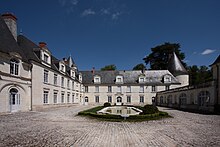Le Gué-Péan Castle
The Le Gué-Péan castle stands on the territory of the French community Monthou-sur-Cher in Loir-et-Cher . Since October 10, 1980 it has been under monument protection as Monument historique .
history
The castle was built in the 16th century - probably including parts of a medieval castle - and modernized again and again until the middle of the 17th century. Construction began by Nicolas Alamand from Angers , a financier under Franz I. He was accused of embezzling state funds together with the Chief Financial Officer, Jacques de Beaune .
Despite these accusations against his 1527 deceased father, his son François Allamand held high offices, and in 1543 was for him fief Gué Péan set up as a lock rule. He was the most important builder for the complex, even if further construction work was carried out after his death in 1555; the front tower, for example, bears the year 1581 in the upper area.
Charlotte Allamand inherited the property in 1649 and sold it in 1676. During the French Revolution , the property, which then belonged to the Amelot family, was confiscated and sold. The descendants of the actual owners bought the property back in order to sell it to the Cassin family in 1832.
architecture
The right-angled inner courtyard of the palace is U-shaped surrounded by three wings. The fourth side is closed off by a wall with the entrance portal framed by two flattened round towers . Four more round towers stand at the corners of the facility. The whole is surrounded by a dry moat, over which a stone bridge leads to the entrance.
The tallest tower with its bell-shaped dome is probably the only one that was completed. The side wings and pavilions are structured by open arcades and have mansard roofs . The main wing at the rear of the courtyard is framed by the two rear round towers with a conical roof .
inside rooms
You can visit some of the rooms with chimneys and Louis-quinze and Louis-seize styles in the castle, which over the centuries has housed numerous kings and famous personalities such as La Fayette and Honoré de Balzac . The Gardensaal (French salle des gardes ), the chapel , the salon and the library, which contains a rich collection of copies of handwritten letters and other historical memorabilia, are particularly worth seeing . The mighty fireplace of the Grand Salon was created by Germain Pilon , one of the main masters of French Renaissance plastic.
literature
- Raymond de Kéguelin de Rozières: Château du Gué-Péan . Société Civile Agricole et Forestière du Château du Gué-Péan (SCIAF), 1980.
- Jean-Marie Pérouse de Montclos, Robert Polidori : Castles in the Loire Valley . Könemann, Cologne 1997, ISBN 3-89508-597-9 , p. 192 .
- Castles and cities of the Loire . Valoire-Estel, Florence 2006, ISBN 88-476-1863-0 , p. 78.
- Castles on the Loire ; The green travel guide. Michelin Reise-Verlag, Landau-Mörlheim 1997, ISBN 2-06-711591-X , p. 244.
- The castles on the Loire . Valoire-Estel, Blois 2006, ISBN 2-909575-73-X , p. 70.
Web links
- Le Gué-Pean Castle website
- Photos from Base Mémoire
- Le Gué-Péan Castle as a 3D model in SketchUp's 3D warehouse
Individual evidence
- ^ Entry of the castle in Base Mérimée , accessed on June 2, 2009.
Coordinates: 47 ° 20 ′ 59.7 ″ N , 1 ° 19 ′ 5.5 ″ E


